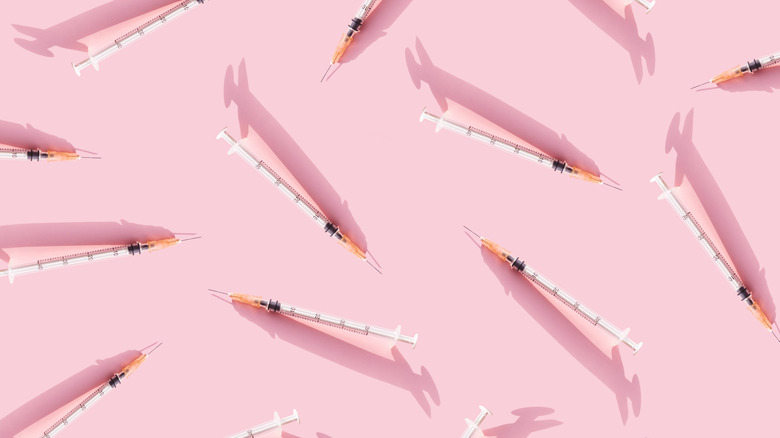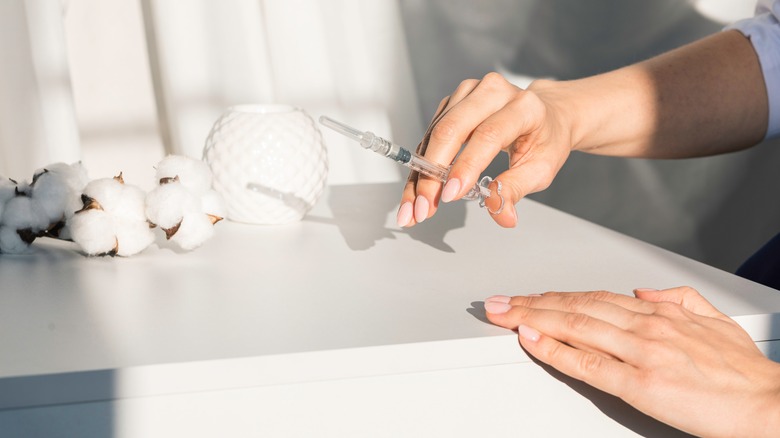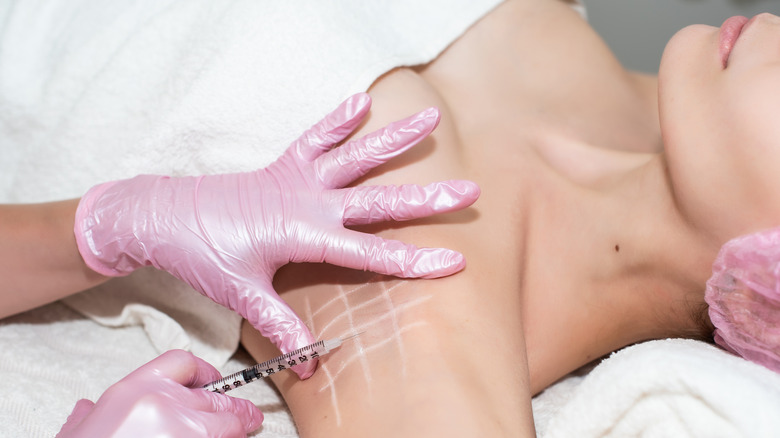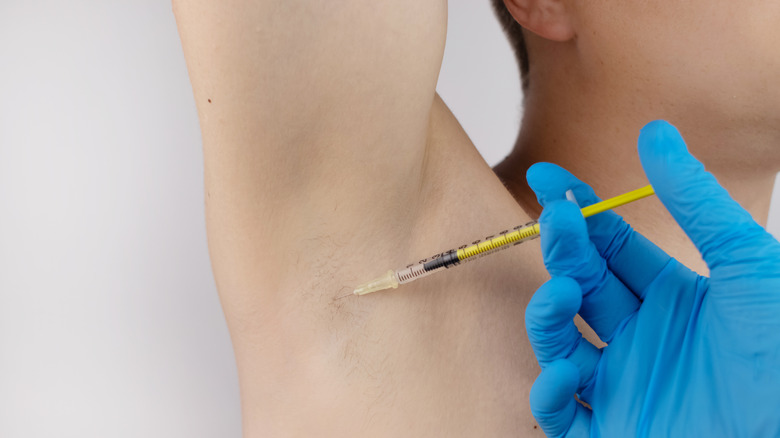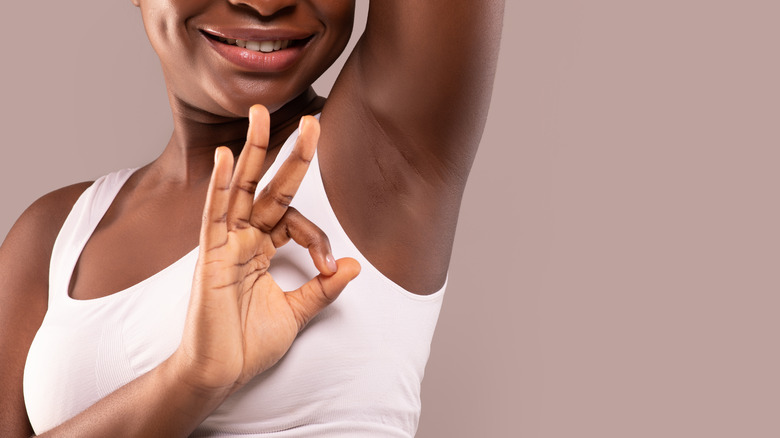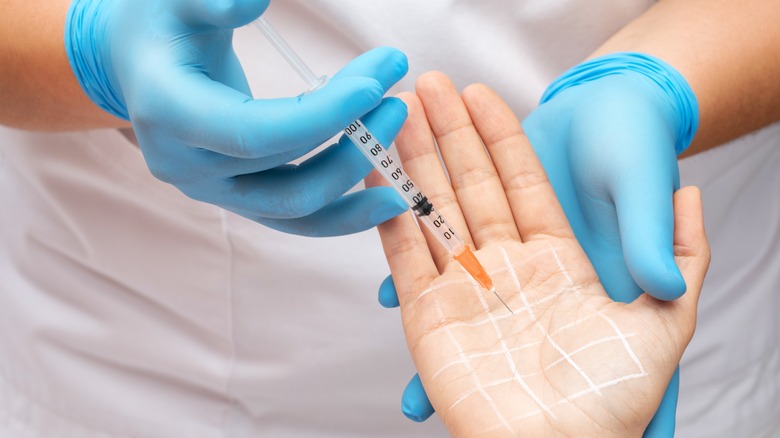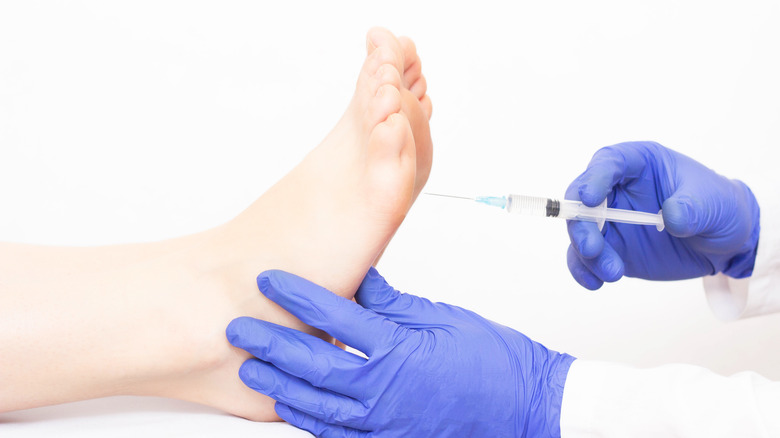Everything You Need To Know Before You Get Botox For Sweating
Sweating sucks. Visible sweat stains can be embarrassing and sweat itself can have an odor. According to Healthline, sweat — or perspiration — is a salt-based fluid that is released from the body's sweat glands. A normal function that works to regulate the body's temperature by cooling it down, sweating can occur during times of high stress, when the body overheats due to environmental factors, or even after eating certain foods. While everyone sweats, some people sweat excessively, to the point of being uncomfortable.
If you're an excessive sweater, you probably own a lot of black clothing, rarely wear anything even remotely close to pastel colors, and have discovered that tie dye is suspiciously good at hiding dampness. Always being a little soggy would make anyone daydream about drastic solutions. Well, as it turns out, Botox can effectively treat excessive sweating. Here's what you need to know before you seek out this type of treatment option.
What is Botox?
A gnarly neurotoxin made from the same microbes that cause a rather violent type of food poisoning, Botox is a popular treatment for cosmetic enhancements — specifically, smoothing out wrinkles on the face. But it has also been approved by the FDA to treat excessive sweating in the underarms, a condition that is also known as hyperhidrosis (via Healthline).
According to the International Hyperhidrosis Society, when Botox is used to treat excessive sweating, it has the unique ability to interrupt the flow of the chemical in the body that signals your sweat glands, essentially shutting off sweating in the injection area. In layman's terms, Botox "blocks the nerves responsible for activating sweat glands," board-certified cosmetic dermatologist Michele Green told Byrdie. And because it is injected just below the surface of the skin, it has the ability to last for several months. With this treatment, you can say goodbye to ruining your day with dripping and dampness.
Does it work?
Botox is a well-tested option for anyone looking to treat their hyperhidrosis as it has been proven to be very effective at preventing the excretion of sweat from underarm glands, the palms of the hand, and even the feet. According to the International Hyperhidrosis Society, the treatment has been shown to result in an 82-87% decrease in underarm sweating, an 80-90% success rate in reducing hand secretions, and about a 50% efficacy rate for feet.
After an injection, wetness should decrease significantly in as little as two to four days, with full results after about two weeks. As for how long it lasts, it varies. Cleveland Clinic reports results can last anywhere from three months to a year, while the International Hyperhidrosis Society recommends returning for another injection after six months.
It's important to note that sweating doesn't stop completely. "The goal of Botox injections is to reduce profuse sweating to a normal or slightly less-than-normal amount," dermatologist Sherry Yu told Cleveland Clinic. "Most people still have a little bit of sweating and may find they need deodorant or antiperspirant. But it varies from person to person."
Is it safe?
Botox was first granted FDA approval in 1989 and has since been named to be an effective treatment option for eight medical conditions in total (via International Hyperhidrosis Society). Before getting a go-ahead from the FDA, a treatment has to pass rigorous safety processes, including a risk assessment (via U.S. Food & Drug Administration) and various stages of lab, animal, and human testing (via Registrar Corp).
As Cleveland Clinic reports, in addition to the underarms, groin, hands, and feet, Botox can be used to mitigate excessive sweating in other, less common areas of the body, including under the breasts, on the head, and on the face. Since the results do fade after a while, its efficacy as a repeated treatment has also been studied, and its use has been proven to result in long-lasting improvements to hyperhidrosis symptoms (via International Hyperhidrosis Society).
Of course, you should always consult your doctor before receiving Botox injections. As is the case with any medication or treatment, there is always a chance that your body will react adversely to it.
Who is this treatment recommended for?
Hyperhidrosis, or excessive sweating, is a fairly common affliction, and most likely underreported (as many potentially embarrassing things tend to be). A 2016 study published in the Archives of Dermatological Research found that hyperhidrosis affected 4.8% of the United States — that's 15.3 million people (via National Library of Medicine). Of those, 70% are experiencing severe symptoms in at least one concentrated area of the body.
The ideal candidates for Botox injections to treat hyperhidrosis are "healthy individuals who have used prescription antiperspirants without success and are looking for a better way to have long-term relief from sweating," according to board-certified dermatologist Michele Green (via Byrdie). Basically, if you've always been bombarded by targeted ads for "life-changing" antiperspirants, tried numerous over-the-counter products, and have also pursued topical or oral prescription options without adverse reactions, you have more than a little in common with those currently receiving injections.
But even if you've exhausted all of the treatment avenues, not all patients are eligible for the procedure. Montana Dillenberg, an aesthetic nurse practitioner, told Byrdie that known exemptions are "pregnant and breastfeeding people, people with allergies to neurotoxins, hemorrhagic conditions, autoimmune disease, and neuromuscular disorders."
Do Botox injections hurt?
According to the International Hyperhidrosis Society, Botox injections are deposited just below the surface of the skin, so the needle isn't some giant scary thing. In fact, Baylor Medicine reports that practitioners use the smallest needle available and also administer an anesthetic cream beforehand to numb the injection area. "The injections are generally well tolerated by patients, and the treatment is very effective," University of Minnesota Health's dermatologist Lori Fiessinger told M Health Fairview. "The underarms, in particular, respond well. Sweat glands on the hands and feet also respond well to Botox injections, but patients tend to find the injections themselves more painful on the hands and feet because there are more nerve endings there."
Some common side effects include light bruising, swelling, and soreness around the affected area (via M Health Fairview). Those receiving treatments for excessive hand sweating have also reported leaving with a weaker grip, but this only tends to only last for a couple of weeks (via Baylor Medicine).
To prepare for the procedure, doctors recommend not shaving (via International Hyperhidrosis Society), refraining from intense exercise for a few days, halting the use of scented underarm products, and staying out of hot baths, showers, and saunas for one to two days before your appointment (via Healthline). You will likely have a two-week follow-up appointment to assess the results, including if any spots were missed.
How much does it cost?
Arguably the biggest drawback of Botox injections to treat excessive sweating is the cost. It's a major expense that depends on factors such as the size of the body area to be treated, the provider you choose, and whether or not insurance will cover any of the cost. According to Healthline, the treatment typically costs about $1,000 for both underarms. Baylor Medicine reports a cost of $900 for both underarms, so the price seems to oscillate around that range.
Of course, if other areas of your body require attention, the bill will increase, and insurance isn't always dependable. Companies want to see a history of other options exhausted first, such as if you've tried many prescription antiperspirants and/or oral treatments without success (via Healthline). Those other avenues cost money too, so take time to weigh your options and even get in touch with your insurance company before scheduling an appointment.
Is it permanent?
Not to bum anyone out, but Botox injections are not a one-and-done type of treatment. Once you begin getting them, it may be hard to stop, especially if your quality of life is vastly improved by a lack of excessive sweating. According to M Health Fairview, after about four to six months, your nerves will start to regenerate, meaning it will be time for another appointment. Exactly how long your results last depend on your body and the severity of your sweating, but dryness does last for quite some time. It just won't last forever.
The injections do work quickly though, with patients reporting a decrease in dampness as soon as two days following an appointment (via International Hyperhidrosis Society). Full results are usually evident after two weeks (via M Health Fairview), so for those of you not shaken by the price or prospect of future injections on a regular basis, you do get to enjoy pretty immediate satisfaction. It's not like trying a prescription acne treatment and needing to stick it out for several months in order to see the complete effects.
Potential side effects
As with any medical treatment/prescription, there are some possible side effects to treating excessive sweating with Botox. According to the International Hyperhidrosis Society, some patients receiving Botox in the face can experience sweating asymmetry. This usually occurs in the forehead and is caused by Botox doses impacting the facial muscles. It's temporary, and can totally be corrected by an additional injection or two. Sweating asymmetry is a good example of a post-procedure change that would probably be pretty alarming at first, but is actually nothing to fear.
Other mild side effects, according to Healthline, include bruising around the injection site, bleeding, headaches, and flu-like symptoms. Rare, but more serious, side effects include muscle weakness, difficulty breathing, and impaired vision. These can occur hours, days, or even weeks after your injections, so it's wise to keep a watch for them and seek medical attention if they become serious.
Busting myths
You've probably heard some interesting fears and myths about getting Botox injections to treat excessive sweating, so let's unravel them. A rather common question is: Does the sweat come out somewhere else? As reported by the International Hyperhidrosis Society, the underarms are home to only about 2% of the body's sweat glands. Temporarily shutting them off doesn't alter the body's temperature-regulating capabilities so drastically that it desperately needs to push sweat out from somewhere else.
Another common myth is: Will you be bone-dry forever making deodorant a thing of the past? Again, Botox isn't magic. Most people can't totally forego deodorant or antiperspirant in the months following an appointment. The lack of wetness can definitely decrease odor, but the Botox injections won't completely eliminate this necessary bodily function (via Cleveland Clinic). You may be one of the lucky ones who can remove deodorant from your shopping list, but most patients will still want a daily underarm application.

